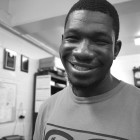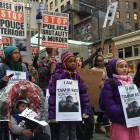
March Until ‘Shoot First, Ask Questions Later’ by Police Stops
|
The topic of alternatives in police practice usually stops at diversion. We need more — alternatives to excessive force, to deadly force.
Juvenile Justice Information Exchange (https://jjie.org/page/197/)

In late September, Torri was driving down the highway with her 11-year-old son Junior in the back seat when her phone started ringing.
It was the Hamilton County Sheriff’s deputy who worked at Junior’s middle school in Chattanooga, Tennessee. Deputy Arthur Richardson asked Torri where she was. She told him she was on the way to a family birthday dinner at LongHorn Steakhouse.
“He said, ‘Is Junior with you?’” Torri recalled.
Earlier that day, Junior had been accused by other students of making a threat against the school. When Torri had come to pick him up, she’d spoken with Richardson and with administrators, who’d told her he was allowed to return to class the next day. The principal had said she would carry out an investigation then. ProPublica and WPLN are using a nickname for Junior and not including Torri’s last name at the family’s request, to prevent him from being identifiable.
When Richardson called her in the car, Torri immediately felt uneasy. He didn’t say much before hanging up, and she thought about turning around to go home. But she kept driving. When they walked into the restaurant, Torri watched as Junior happily greeted his family.
Soon her phone rang again. It was the deputy. He said he was outside in the strip mall’s parking lot and needed to talk to Junior. Torri called Junior’s stepdad, Kevin Boyer, for extra support, putting him on speaker as she went outside to talk to Richardson. She left Junior with the family, wanting to protect her son for as long as she could ...

The topic of alternatives in police practice usually stops at diversion. We need more — alternatives to excessive force, to deadly force.

Within the world of juvenile justice, law enforcement and corrections officials are re-examining theories and punishments associated with juveniles. This book is a valuable resource for academic courses designed to compare and contrast juvenile justice systems and gain an appreciation of how different cultures approach juvenile justice.

In 2015, California came three steps closer to realizing the founding concepts of the juvenile justice system and securing successful re-entry for justice-involved youth.
When I first joined my gang, I was 12. I believed that I wanted to be from my gang. Most of my family I grew up with was from the hood; it seems that I was destined to be too.

It’s been 2½ years since Georgia Gov. Nathan Deal signed a landmark overhaul of Georgia’s juvenile justice system into law. The measure has resulted in a sharp drop in commitments to the state’s youth correctional system and is expected to save tens of millions of dollars by replacing incarceration with community supervision.

“What we’ve got here is failure to communicate.”
The captain, a prison warden, uttered these words in the movie classic “Cool Hand Luke” after beating Luke with a whip for his stubborn disobedience.
These words describe the underlying cause of the South Carolina classroom altercation resulting in the firing of a deputy.

James Milan entered foster care at age 4. “My childhood wasn’t the greatest,” he says wryly. “I was trying to figure out why my mother didn’t want me, why my father wasn’t there.” In and out of foster care homes and group homes, he found the Claremont Neighborhood Center in the Bronx, N.Y., — and now works as a senior counselor there with kids ages 5 through 13.

One speaker at the New York march for Tamir Rice was inspired by the leadership of young people who led the march. He said he hoped it emboldens other adults to stand up with young people and get them involved in what he sees as a crucial historical moment.